“Guitar was my everything”: Tame Impala’s Kevin Parker on 10 years of InnerSpeaker
In the decade since Tame Impala’s debut album, Kevin Parker’s psychedelic rock project has grown into a Grammy-nominated behemoth. But back then it was just about a man, his guitar and the Indian Ocean.
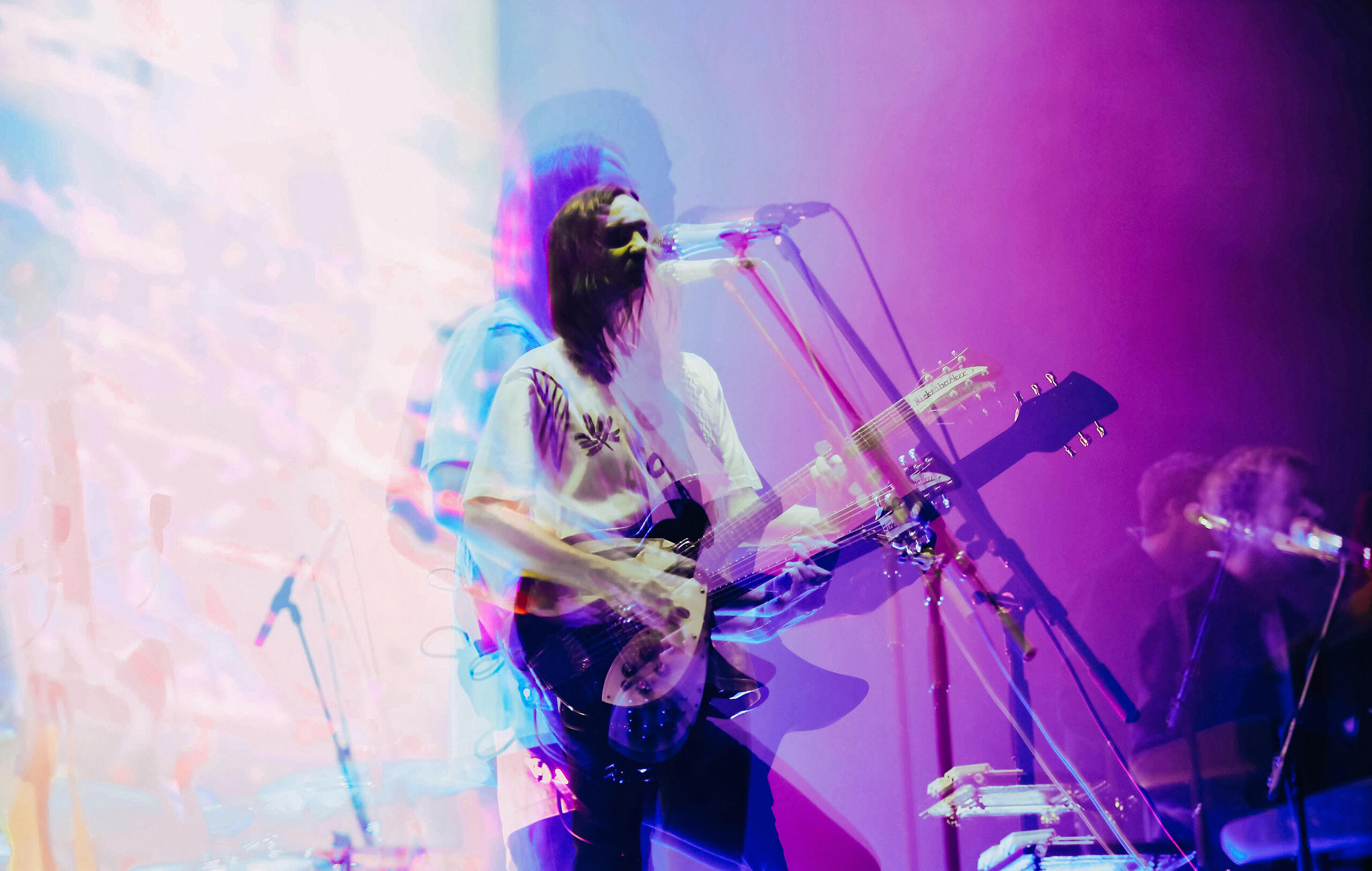
Image: Matt Winkelmeye / Getty Images
“It was really moving, I didn’t expect it to be.” Kevin Parker is reflecting on returning to his debut album, InnerSpeaker, for its forthcoming 10-year reissue box set, and the emotions that come to the fore when you crack the amber on a formative moment in your life.
“I actually found the 16-track recorder that I recorded it on, which I haven’t bothered to pull out of its box for 10 years,” Parker tells us on an early morning Zoom call from his home in Australia. “I kind of assumed that the hard drive had shat itself, y’know? I didn’t expect it to work! But it just turned on, and all the songs were there. I started listening to all the sessions in the order I’d been working on them in the house ten years ago, and it just reminded me of so much more than just the songs themselves. It’s a snapshot of who I was then. So much has happened since, I’ve kind of forgotten what it felt like to be a wide-eyed kid, unsure of who he is, trying to prove himself through music.”
Joined for live performances by his mates Dominic Simper and Jay Watson, Parker had been performing and recording as Tame Impala for a couple of years at this point, but had just a self-titled EP of Parker’s bedroom recordings to show for his deal with Aussie label Modular Recordings. That was about to change, as Parker decamped with his gear to a beach house with the aim emerging with his first real statement as an artist. It’s no small amount of pressure for a young man whose previous recording experience had been on a much smaller scale.
“I was daunted by the whole task of having to make an album that was then going to be marketed and sold to the public”
“I was approaching it like, ‘How am I going to do this?! Holy shit I have to make an album!’” Parker recalls. “I can’t overstate how much that was the feeling! Because up until that point I had only made solo recordings of myself in my bedroom. I’d been signed to a record label, but I’d just made songs with a pair of headphones. I was daunted by the whole task of having to make an album that was then going to be marketed and sold to the public, and money was meant to be made off it!”
For most artists, the thought of having to craft an entire album on your own, playing pretty much every note and beat on the thing yourself would also be pretty daunting, but for Kevin, the opposite was true, because Tame Impala was being presented as a ‘band’ in the traditional sense at this point, as opposed to a solo endeavour with a fixed live band.
“I felt there was a pressure on me to make it more of a ‘band’ album,” he admits. “Just because the machine of the music industry had put us in that box, and so that’s what I felt like people were expecting. Also, Jay and Dom are my two best friends, and I felt responsible in a way for it to be fulfilling for them too, not just for myself. So that was a difficult thing, because I didn’t want them to feel like they were just waiting in the wings while I made this album.
“But the ‘me recording’ bit was bread and butter, because I’d spent so many years – since I was a kid – making music on my own. Making music on my own is and always has been easier than making it with other people – a hundred times easier. Because if I’m playing or writing a guitar riff, I hear the drums in my head and just play them. It takes out an entire section of communicating it to someone.”
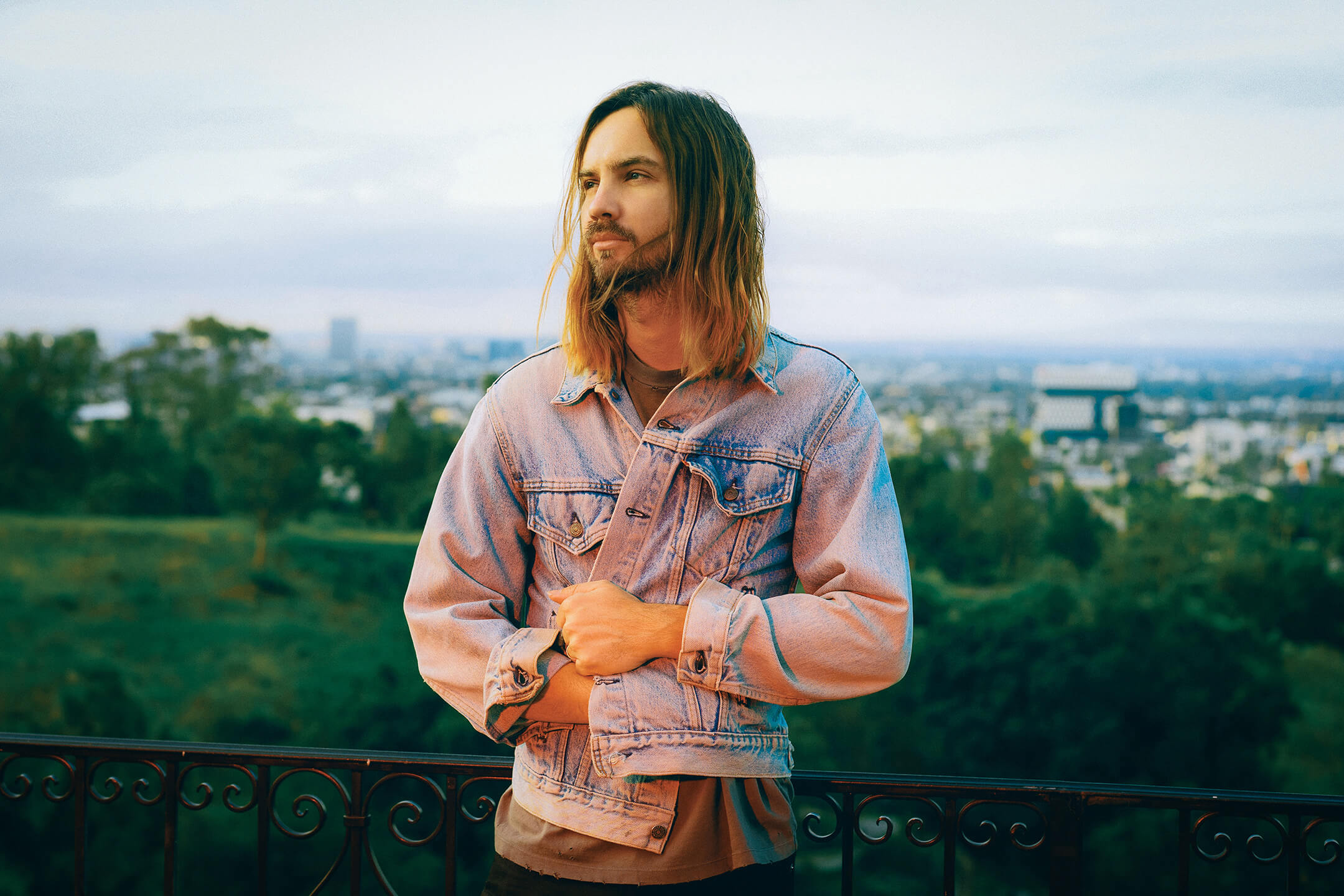
House of fun
In the lore of InnerSpeaker, the recording location has become something of a character in itself. The Wave House is a beach shack that overlooks Injidup Beach in Western Australia, offering stunning 180-degree views of the Indian Ocean, but no internet, phone or TV – even electricity wasn’t a given back in 2009. It’s a place that clearly means a lot to Parker (he reportedly bought the property when it went up for sale in 2020) as the place where Tame Impala emerged from its larval state.
“It’s funny because now it’s so intrinsically linked with the music,” he reflects. “Even when I listen to InnerSpeaker now I just hear the sound through those walls – I can hear the drum reverb in those walls. But it wasn’t meant to be that way. The record label was asking which studio I wanted to record in, and I just said that I just wanted a shack by the beach, and my manager happened to know someone a few hours south from Perth, where I live, and that’s how we found the house.
“I’m always the type of person that hates to say like, ‘Oh the scenery informed the music’. I hate to think that you need beautiful scenery or a beautiful environment to make music, because up until that point I’d made majestic psych-rock in a shitty shared house, in my shitty room with a pair of headphones, you know? It wasn’t like, ‘Oh now I can make beautiful music!’ So I’m never one to say it informed the music, but you know, it probably did a little bit! Because when you’re staring at a beautiful ocean anything you play is going to sound beautiful, and so it makes it easier to go, ‘This song is finished’.”
“I’ve always gotten a kick out of disorientating people as to what kind of sound they’re listening to. It’s the same kind of a thing a magician gets out of making people go, ‘Woah, what the fuck?’”
Anyone who has written and recorded a song will know that the hardest part is knowing when to leave it be, and so it’s interesting that for the 10th Anniversary box-set, Parker has decided to include remixes of tracks Alter Ego and Runway Houses City Clouds. Was this simply a more experienced, confident Parker wanting to take a fresh look at things, or was there something about the mixes on those tracks that had been bugging him for a decade?
“I was happy with how it sounded – I mean I was a fucking headcase by the end of the mixing sessions and Dave Fridmann was so good at managing me,” he chuckles. “Every artist knows the torment of finishing an album, and it can just be the pits. I’d been listening to the songs every day for however many months and you lose all objectivity – it’s completely out the window.
“And so with Alter Ego especially, I had a vision for the song that I just wasn’t able to capture sonically. The way the song is, it’s kind of charming to me because it’s this guitar-playing psych-rocker trying to make music that he thinks sounds like The Chemical Brothers. But I was just using the tools I had. But there were just a few things sonically that I wanted to bring out to trigger an alternative listening experience.”
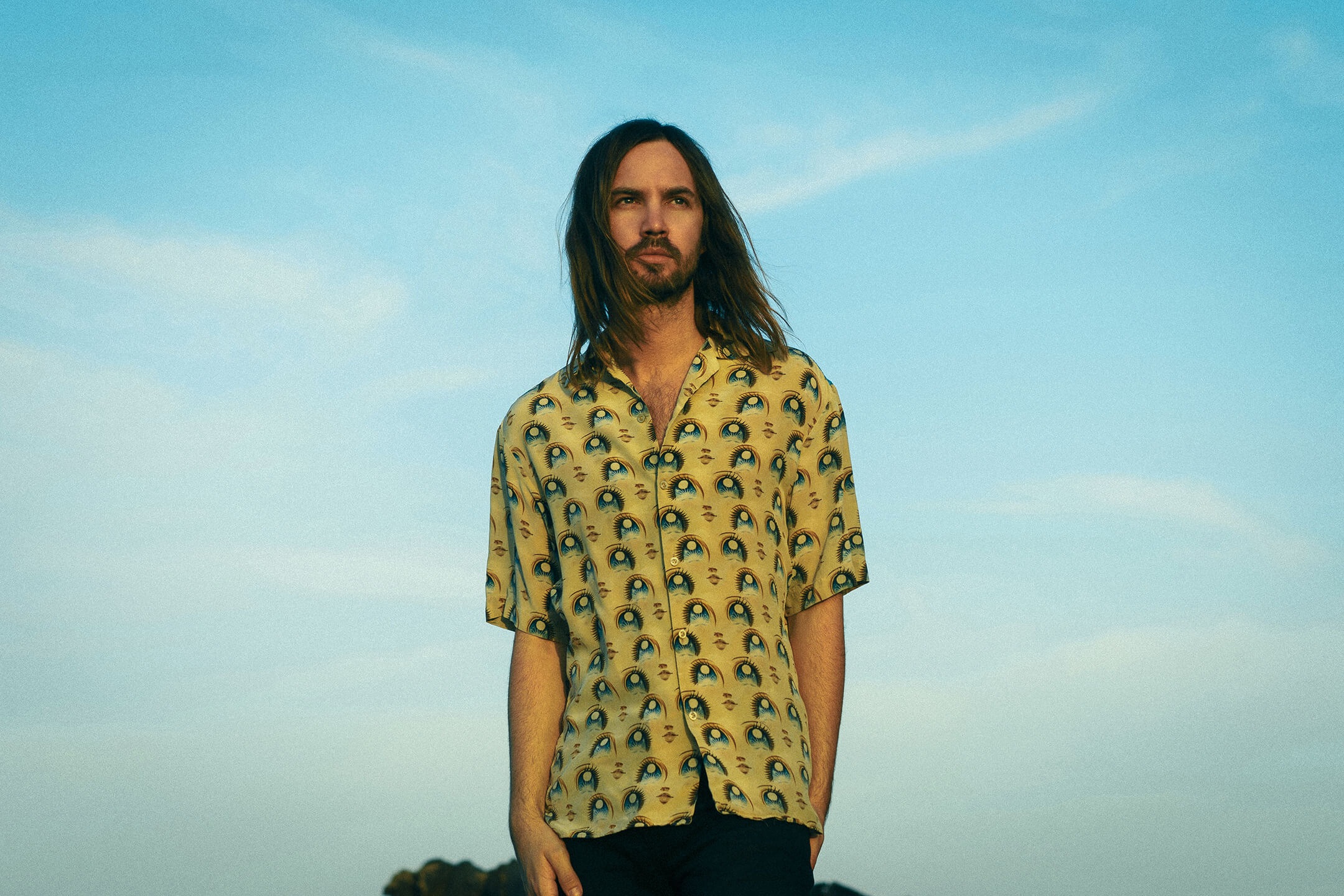
Tools at hand
One of the most rewarding things about listening to InnerSpeaker is the myriad ways in which Parker mangles and twists his guitar to sound like all manner of other instruments he needed to create the record’s dream psychedelic soundscapes – in fact sometimes you’d be hard-pushed to know exactly what it is you’re listening to.
“I’ve always gotten a bit of a kick out of disorientating people as to what kind of a sound they’re listening to,” he says. “It’s like a trick, you know? It’s the same kind of a thing a magician gets out of making people go, ‘Woah, what the fuck?’ It’s probably similar to the appeal of psychedelic music – that disorientation.
“Also, even though I’ve always appreciated lots of different types of music, musically back then, aside from drums and bass, guitar was my everything. So if I wanted an organ sound, I had to try and make a guitar sound like an organ. I’d take the attack off, roll the tone knob off, play with my fingers rather than a pick. I had to do things like that because I didn’t own any keyboards or synthesizers, but I also liked the idea that I could do it without synths, y’know? I was young enough to be that stuck up and closed-minded that I was like, ‘Oh no I don’t use synthesizers, I use guitars to makes a synth sound…’ I was that age!”

What’s even more impressive is that all of these weird and wonderful sounds were being created primarily on one instrument.
“99 per cent of the guitar on that album is Fender Strat,” Parker notes. “I bought it off a friend, it was my touring Strat at the time… it was my only guitar at the time! Those were the days I only really owned one guitar at a time: ‘Want a new guitar? I guess I’m selling my guitar!’
“So it was a combination of my live rig – which is an AC30 and a handful of pedals – and recording guitar straight into my eight-track because it had all these presets that I would fuck with. I didn’t even know what I was doing! A lot of sounds on that album are directly from my eight-track – I’ve gone into the parameters and just spun the wheel! You go to the EQ section, and you’re just like, ‘I’ll turn some of that up, see what it sounds like… nope that sounds bad, go to the next one and just turn that up… oh that sounds pretty good!’ There’s a guitar sound that we called ‘space guitar’ – it’s a lead sound that sounds like an octave-shifted guitar, very digital and synthetic, but I love that. That was just me messing around with presets and parameters – I didn’t even know what they did.”
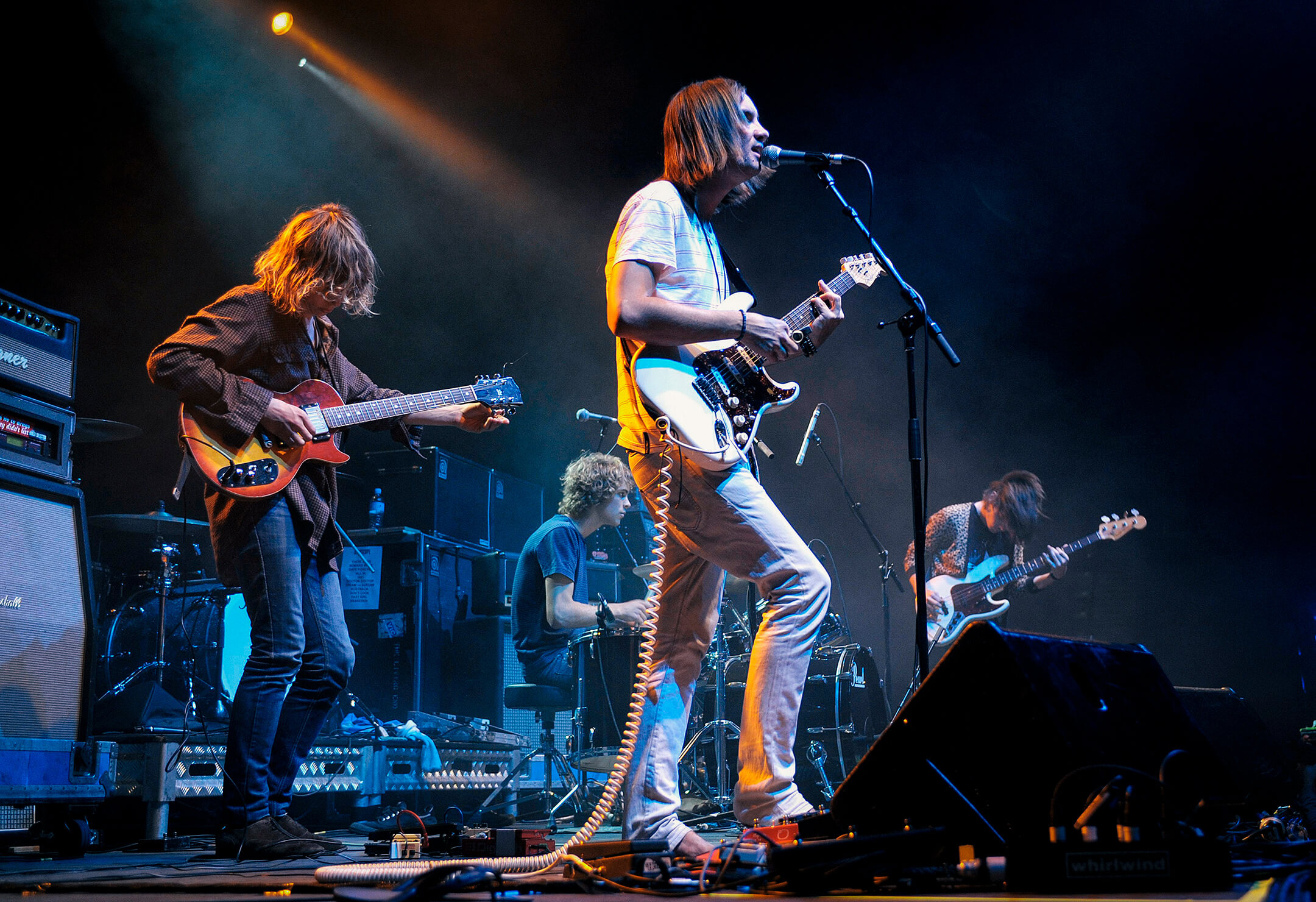
Hank marvelling
So how does a young musician with a passion for electronic sounds end up making them with guitar in the first place? Well, the long answer involves the unexpected influence of another player who knew how to create an atmospheric soundscape in his day…
“My dad played guitar daily, and he was obsessed with The Shadows and with Hank Marvin,” Parker reveals of how he came to play the guitar. “Drums were my first instrument, but that didn’t really do him any good when he wanted to play Shadow’s lead, so I basically started playing guitar learning the rhythm guitar to Shadows songs. To this day I think that’s the source of why I consider myself to have a really good sense of rhythm when it comes to playing guitar. I’d also look up guitar tabs on the internet, like Silverchair songs. Discovering tabs was a huge development for me as a kid – it took guitar from this thing that I just played with my dad to like, ‘Holy shit I can suddenly play all my favourite songs!’ Ever since then, guitar became my main thing.”
“About 99 per cent of the guitar on InnerSpeaker is Fender Strat. I bought it off a friend. It was my touring Strat at the time – it was my only guitar at the time”
Almost immediately, Kevin’s interest in playing music turned into a need to create music and songs of his own.
“I’ve always liked making new things going back to when I was super young,” he says. “Whether it’s drawing pictures or playing with Lego or whatever, making something new has always been the peak of doing anything. Making something new with that skill is the pinnacle of doing it, you know? So immediately, as soon as I played music it was like, ‘Oh, I’m going to write a song,’ because then it was my own thing.”
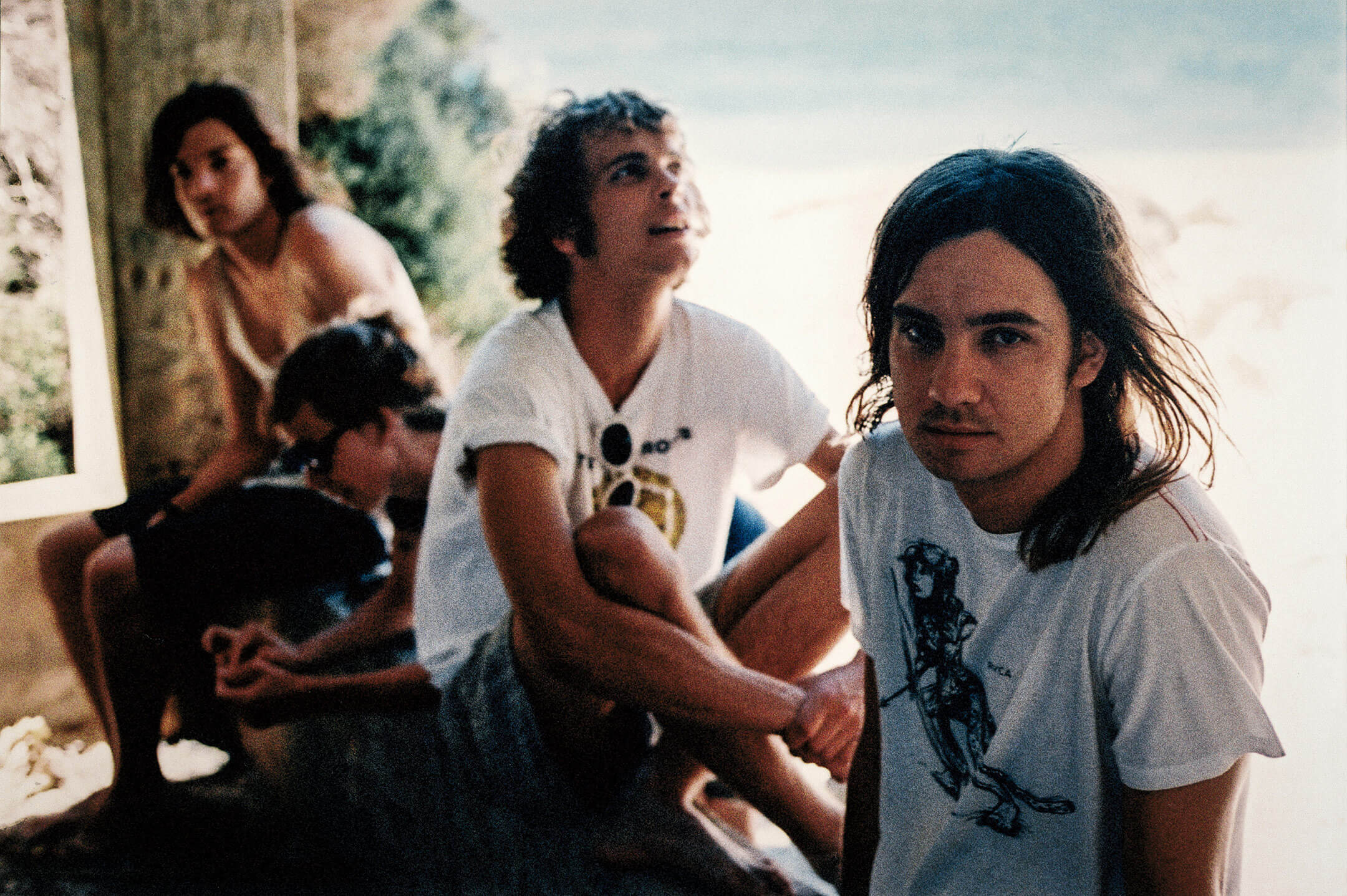
Bet on ‘Backer
Kevin’s first recordings as Tame Impala might have been predominantly Strat, but shortly after he finished the initial recording, he took a trip to Japan and met the ’67 Rickenbacker 335 that would become his calling card. Rickys are, it’s safe to say, an acquired taste in terms of their playability and sound, but for Parker, that’s the point.
“It just sounds like no other guitar,” he insists. “There’s just something about the ‘tonk’, or the ‘honk’ or whatever you want to call it. It’s funny because I never knew people didn’t like playing Rickys but, ever since I’ve been touring with that guitar, no one else will pick it up. Anytime anyone picks up my guitar they’re just like, ‘Oh fuck this! It feels like rubber bands… it feels like a toy!’
“But it’s true – I never shred on that guitar, it’s really hard to do solos on, but it just has a sound. The sound of it makes me dream. It’s just evocative. I can’t decide if it’s because of Beatles music, or just because it sounds different, I don’t know how to describe it. Strumming on a Rickenbacker is just a different feeling altogether.”
“The thing about playing a Les Paul is it sounds like every album that has been made with Les Paul. It’s so much harder to get a unique sound”
Parker has added a few other Rickys to share the load with the ’67 on tour since then, as well as that old mongrel Strat and a few other bits and pieces over the years, but safe to say that Parker is not a man sitting on a huge collection of vintage gear.
“Put it this way, I don’t have any guitars that I haven’t used on stage,” he laughs. “So, if you tally up all the pictures of me playing different guitars on the internet, that’s how many guitars I have! I’m not a ‘collector’ – I’m not like, ‘Oh I really want a 1959 Strat…’ y’know? If I have something that sounds like that, it’s good enough for me.”
Parker might not be obsessing over serial numbers and Bakelite knobs any time soon, then, but he’s always on the lookout for something a little bit different that, to his mind, gives you something that you won’t get from a more famous guitar…
“I bought a blue Teisco – I don’t know what the model, super cheap – but just sounds completely different,” Parker enthuses. “If you play like some Nile Rodgers funk guitar on the top three strings, it just has a vibe. It sounds like you’re listening to some forgotten album. Which I just don’t think you can get from the classics. The thing about playing a Les Paul is it sounds like every album that has been made with Les Paul. It’s so much harder to get a unique sound. It’s just about having a footprint – the Rickenbacker has a footprint, the Teisco has a footprint.”
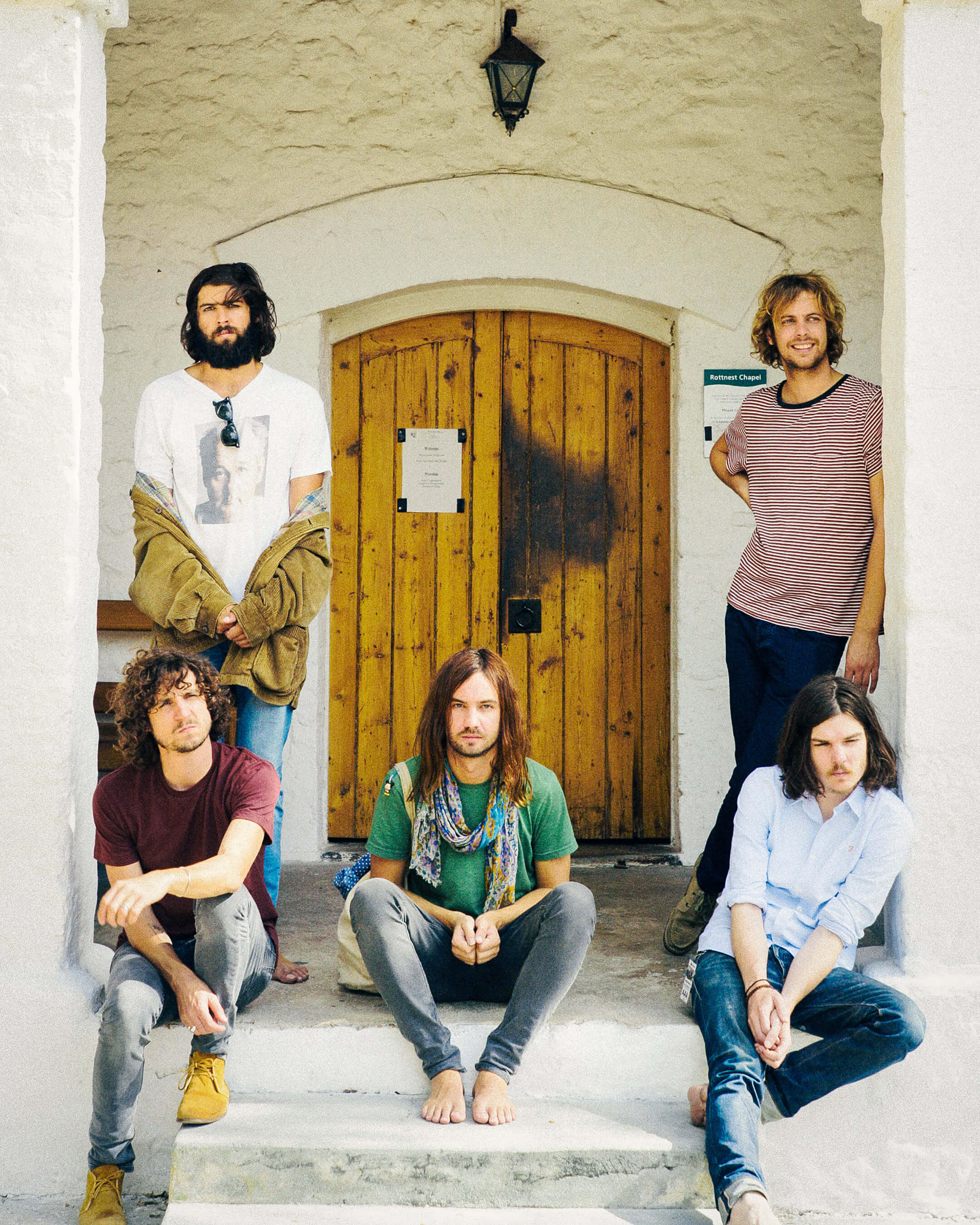
Tamed impala
When it comes to making music in the studio, however, it’s another leftfield choice that Kevin finds himself reaching for more often than not – and for a very utilitarian reason.
“I bought a Hagstrom Impala at the Chicago Music Exchange,” he begins. “Jay said, ‘Hey Kevin there’s a guitar over here called an Impala’ and we were on tour, and I think maybe we’d just started to make some money or something so I was like ‘Fuck yeah I’m gonna buy it!’ Then Hagstrom ended up reissuing the Impala, and they sent me a couple, and I just love the way it’s all switches. There’s a treble boost and the tones, but it’s all switches except for the volume.
“I’ve grown to love that in the studio because it means the settings are always really easily recalled. So if you record a part, and you want to go back and record something as alternative take months later, you can do that because it’s a combination of six switches!”
It’s an interesting window into how he approaches the instrument when recording, and an important lesson on what ‘good tone’ really is when it comes down to it.
“The sound of my Rickenbacker makes me dream. It’s just evocative. I can’t decide if it’s because of Beatles music or just because it sounds different – It’s just a different feeling altogether”
“It sounds terrible, but I hardly ever think to myself, ‘Oh okay I’m gonna record this guitar part what guitar am I going to use?’ It’s always just the closest guitar to me and I’ll play it, get a good sound on it and play it, and that’s the guitar sound,” Parker explains. “After that, I can’t imagine the guitar part being any other sound, but it was just literally the guitar sitting next to me. Because by the time I’ve had the time to think about the sound, I’ve recorded it and I’ve moved on. For me making songs is kind of like that, I just wanna get it down before I forget it or before I fall out of love with the idea.”

Pull the plug
Given that Parker’s last album, 2020’s The Slow Rush was an almost entirely electronic record, it’s surprising to hear him recoil when we ask him about the increasingly common practice of using plug-ins, amp sims and other digital marvels to record guitar.
“I don’t know why I feel weird about it, but I feel weird about using plug-ins to get a guitar tone,” he admits. “Maybe it’s because I feel my inner 16-year-old screaming! I’m not one of those people that will record a guitar completely clean into a nice preamp, no clipping, into the computer and then sculpt the tone there – something about that gives me the heebie-jeebies. Maybe it’s because it’s like you’ve got too much time to consider the sound.
“Guitar tone is one of those things that I like locking in there and then, and then that’s the sound. Because the sound is so linked to the guitar part, possibly more so than any other instrument. All of the most famous, most classic guitar riffs of all time wouldn’t be those riffs if it wasn’t that sound. And plug-ins are plug-ins y’know. I’m just kind of ehh – it’s all about pedals!”
“I feel weird about using plugins to get a guitar tone. Maybe it’s because I feel my inner 16-year-old screaming! But Something about It gives me the heebie-jeebies”
Speaking of which, we’re intrigued to see how his set-up has evolved in that regard since that first time he went to the Wave House in 2009…
“I still have my Seymour Duncan KTG-1 Preamp, which is kind of my go-to,” he affirms. “I almost don’t bother recording guitar unless I’ve got that nearby. Just because it’s instant mojo – I don’t know what it is? It sounds like I’m listening to an album. I think that can sum up a lot of my tone searching and guitar playing – Does it sound like I’m playing on an album?’
“I actually use a lot of the same pedals that I always have, the Boss Blues Driver, MXR Dyna Comp, the Holy Grail – I can’t imagine using a different reverb, and it’s been 10 years now! I also just love the Roland Guitar Synth, you can get some wild stuff out of those things.”
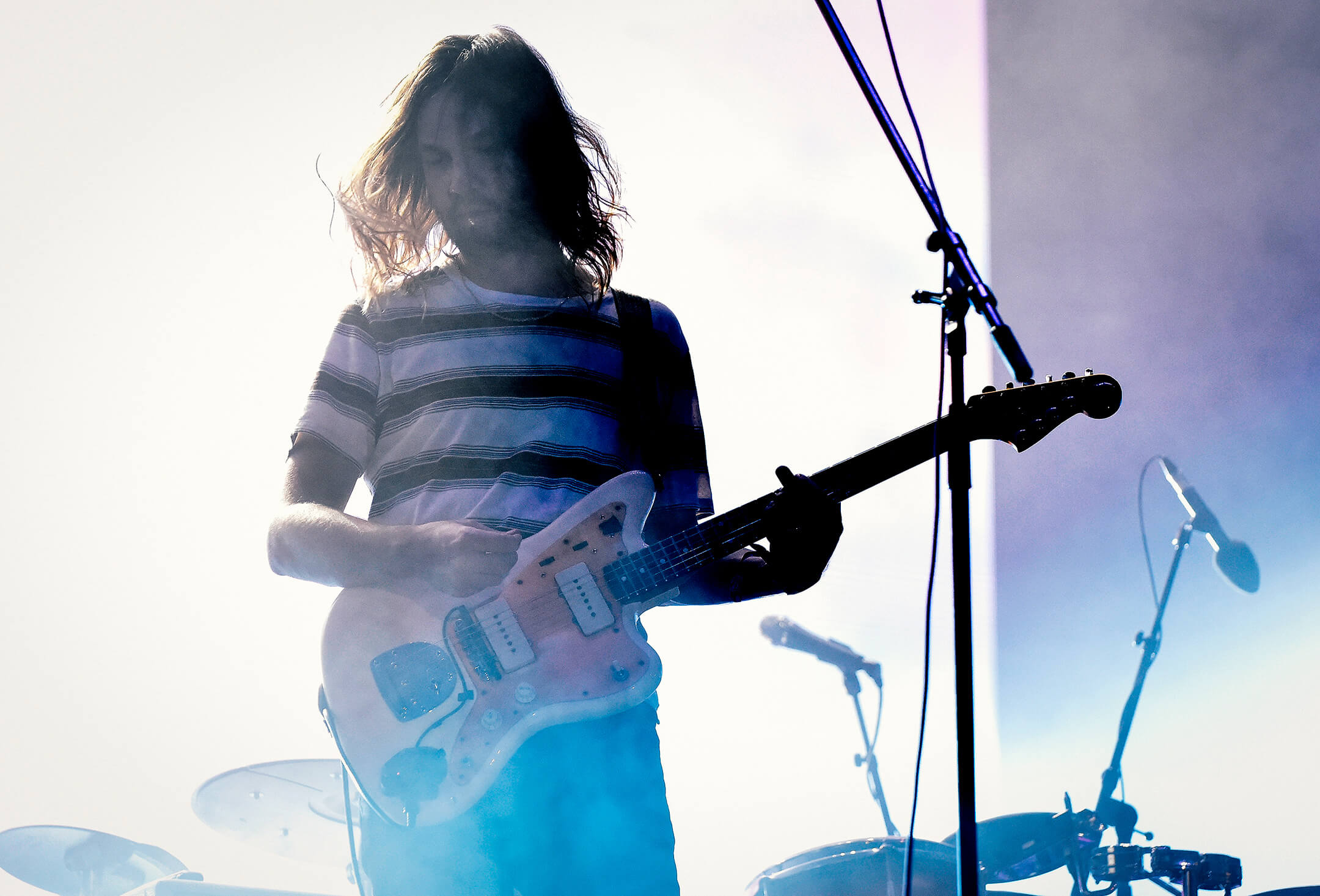
Homeward bound
In many ways, it seems that Parker has stayed true to the gear and ethos that served him when he was making music in his bedroom and ridden it all the way to headlining Coachella and beyond, but taking the time to revisit InnerSpeaker has clearly reminded Parker of how much things have changed, and also how they haven’t…
“If anyone was able to go back and see a day in their own life ten years ago, it tells you so much that memories forget,” he reflects. “There’s little recordings of us talking, me and Dom. I’d have friends come to visit us because the house is so nice, and sometimes I’d hit record while we were just goofing around, and I can hear myself talking and I just remember thinking how socially awkward I was… not that I’m David Letterman now!
“I never realised how much I wanted to prove to myself that I could do it, y’know? Music was everything to me – and still is – but in terms of feeling good about myself, music then was everything. And that’s just what I remember.”
Tame Impala’s InnerSpeaker 10th Anniversary boxset is available now on Modular Recordings.
